About
What is Project EAT?
Project EAT is a large and comprehensive, longitudinal body of research examining trajectories and predictors of a broad array of weight-related outcomes across the life course from adolescence through adulthood. The Project EAT research study was established by Dr. Dianne Neumark-Sztainer in 1997 with the goal of learning more about the broad spectrum of eating and weight-related problems that impact young people in order to guide the development of innovative and effective interventions. The Project EAT program of research is aimed at achieving Dr. Neumark-Sztainer’s vision whereby young people from all backgrounds will have positive weight-related health, with support from their family, friends, schools, worksites, and neighborhoods.

Website Citation
Division of Epidemiology and Community Health. (2020). Project EAT. https://www.sph.umn.edu/research/projects/project-eat/.
Questions?
Contact us directly at projeat@umn.edu.
Preventing problems before they start
When young adults eat well and are active, it can set them up for a lifetime of good health. Watch how Project EAT helps adolescents find their way to wellness.
Project EAT Research Aims
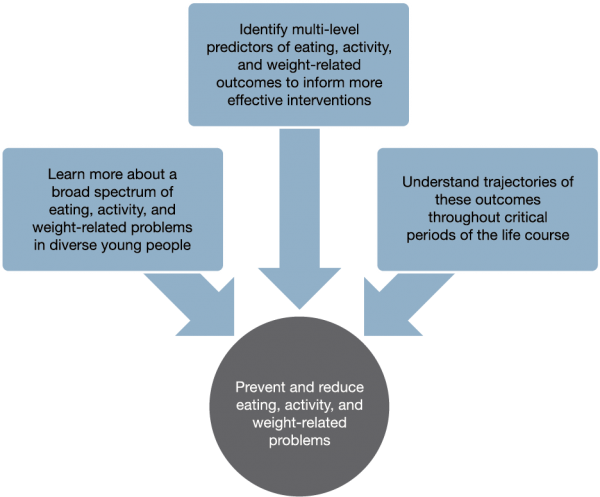
EAT I-IV: Eating and Activity in Teens and Young Adults
Project EAT began in 1997 with funding from the Maternal and Child Health Bureau, Health Resources and Services Administration (R40 MC 00125). At that time, little was known about the factors that influence adolescents’ weight-related health. Project EAT-I was designed to fill this gap in knowledge and identify socio-environmental, personal, and behavioral correlates of dietary intake, physical activity, and weight status.
Initially designed as a cross-sectional study, Project EAT-I included three phases of data collection: 1) focus groups with adolescents; 2) school-based surveys and anthropometric measurements with middle school and high school students; and 3) surveys with parents. More than 4,700 diverse adolescents (11-18 years) from 31 metropolitan area middle and high schools in Minnesota completed surveys about their eating habits as part of Project EAT-I. The success of this initial study and the strong interest in the results from other researchers, media, and parents led to the decision to continue following participants and learn about trajectories in weight-related health over time.
Subsequent funding from the Maternal and Child Health Bureau, Health Resources and Services Administration (R40 MC 00319) and the National Heart, Lung, and Blood Institute, National Institutes of Health (R01HL084064, R01HL093247, R01HL116892), supported five-, 10-, and 15-year longitudinal follow-up studies as the cohort of young people transitioned through adolescence to adulthood. Since follow-up continued into adulthood, and the study expanded to assess physical activity more thoroughly, the name of the study changed to “Eating and Activity in Teens and Young Adults.” We currently refer to the whole body of Project EAT research as “Project EAT: Eating and Activity over Time.” Thus while the full study name has changed to be relevant to each study wave, our acronym, “Project EAT” has remained the same.
EAT 2010-2018: Eating and Activity over Time
EAT 2010 was designed to build on the initial Project EAT study by examining secular trends over time, incorporating a broader ecological perspective, and focusing on weight-related health among adolescents from low-income households and ethnic/racial minority backgrounds. To allow for the examination of secular trends, EAT 2010 collected similar surveys and anthropometric measures as Project EAT-I in a new cohort of nearly 2,800 students from 20 public schools in the same metropolitan area of Minnesota during the 2009-2010 academic year. In addition, the more comprehensive design of EAT 2010 involved the collection of data on adolescents’ family/home, friends, school, and neighborhood environments.
Funding from the National Heart, Lung, and Blood Institute, National Institutes of Health (R01HL127077; R35HL139853) has supported a 7-year follow-up of the EAT 2010 cohort as they transitioned from adolescence to emerging adulthood and will support future follow-up of the EAT 2010 cohort to inform multi-level explanatory models and interventions to help prevent weight-related problems in our most vulnerable populations.
Study Phases
EAT I-IV Cohort
More than 4,700 adolescents from 31 metropolitan middle and high schools in Minnesota completed surveys as part of Project EAT-I. Baseline surveys and anthropometric measurements were completed in school classrooms during the 1998-1999 school year. In addition, a similar telephone survey was administered to a randomly selected sample of parents of adolescent participants.
Study Aims
Project EAT-I aimed to:
- Determine if adolescents were meeting Healthy People 2000 Objectives for dietary intake and weight status;
- Assess which subgroups of adolescents were at greatest risk for not meeting these objectives; and
- Identify socio-environmental, personal, and behavioral factors that are associated with dietary intake and weight status.
Research Design
Project EAT-I included three phases of data collection:
- Focus groups with 141 adolescents
- Surveys and anthropometric measurements with 4,746 adolescents
- Telephone-administered surveys with 902 parents
Focus groups were conducted with 141 adolescents to ensure all relevant factors affecting their eating behaviors would be included in the model and survey.
Theoretical Model Guiding Project EAT-I
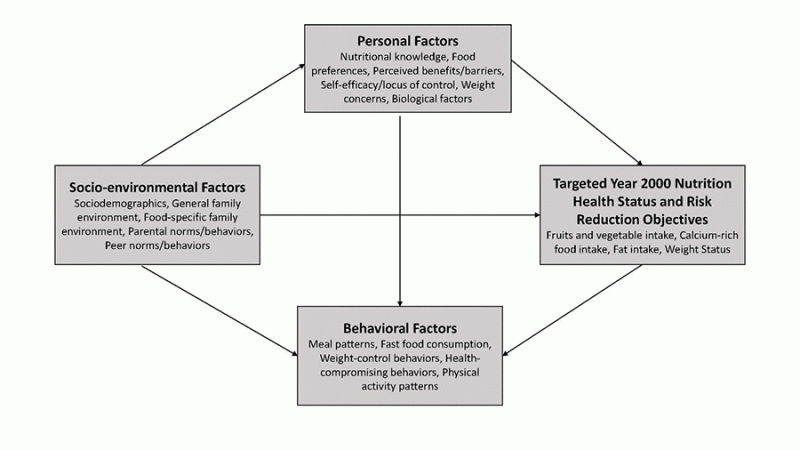
Surveys were administered by trained research staff to middle and high school students in the Minneapolis, St. Paul, and Osseo school districts in Minnesota. Students completed a food frequency questionnaire and the Project EAT Student Survey (n=4,746). The Project EAT Student Survey included questions on self-reported height and weight, potential correlates of dietary intake, physical activity, body image, and weight control behaviors. After completion of the surveys, height and weight measurements were collected from students privately using a standardized protocol.
A similar telephone-administered survey focusing on socio-environmental factors was completed by parents (n=902) of student participants. Random selection was done after stratifying students by ethnicity in order to assure adequate representation from each group.
Participants in Project EAT-I
4,746 adolescents participated in Project EAT-I.
Gender:
- 50% females
- 50% males
Mean Age:
- 14.9 (range 11-18)
Grade Level:
- 34% middle school students
- 66% high school students
Ethnicity:
- 49% Caucasian
- 19% African American
- 19% Asian American
- 6% Hispanic
- 3% Native American
- 4% Other
Funding Source
Grant R40 MC 00125, Maternal and Child Health Bureau (Title V, Social Security Act), Health Resources and Services Administration, Department of Health and Human Services (PI: Dianne Neumark-Sztainer)
EAT-II followed the same participants surveyed in Project EAT-I during their transition middle school to high school (younger cohort) and high school to emerging young adulthood (older cohort). Approximately 2,500 participants completed follow-up surveys assessing personal, behavioral, and socio-environmental factors thought to influence eating behaviors. Data collection was completed in June 2004.
Study Aims
Project EAT-II aimed to address questions about weight-related health relevant to weight status, weight control behaviors, physical activity, and dietary intake patterns targeted in Healthy People 2010:
- Have there been secular trends in weight-related health over the past 4-5 years?
- What important changes in weight-related health occur as youth progress through different stages of adolescence?
- What socio-environmental, personal, and behavioral factors are most predictive of weight-related health during these different stages?
- How does the prevalence and predictors of weight-related health outcomes differ for youth by sex, race/ethnicity, and socioeconomic status?
Research Design
The Project EAT-I survey was revised for Project EAT-II and two versions based on the theoretical model were developed for the younger and older cohorts. Some items from the original survey were dropped due to data redundancy (e.g., childhood weight) and several new items were added following focus groups with young adults that raised topics of relevance to the post-high school cohort.
Theoretical Model Guiding Project EAT-II
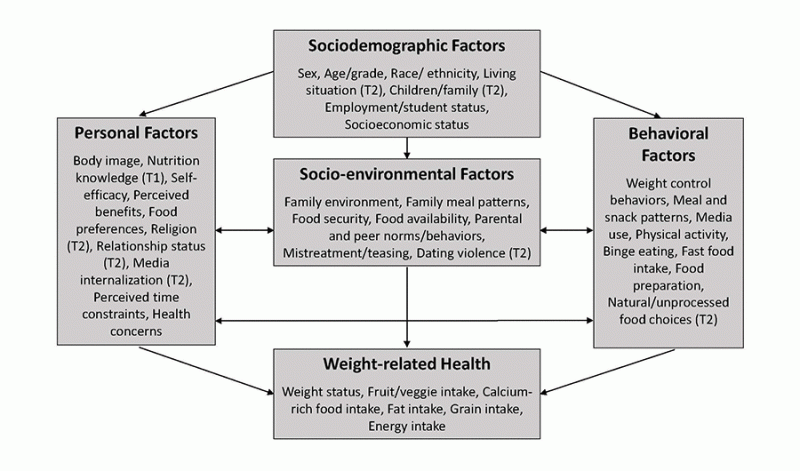
Between April 2003 and June 2004, Project EAT-II surveys and food frequency questionnaires were mailed to both cohorts by the Data Collection and Support Services in the Division of Epidemiology and Community Health, University of Minnesota. An effort was made to include as many of the original participants as possible.
Participants in Project EAT-II
Of 3,672 EAT-I participants contacted by mail, 2,516 participants responded to the EAT-II follow-up survey (68.5% response rate).
Gender:
- 55% females
- 45% males
Grade level:
- 32% high school
- 66% post-high school
Mean age:
- 17.2 years (high school cohort)
- 20.4 years (emerging young adult cohort)
Ethnicity:
- 61% Caucasian
- 11% African American
- 18% Asian American
- 5% Hispanic
- 2% Native American
- 3% Other
Funding Source
Grant R40 MC 00319, Maternal and Child Health Bureau (Title V, Social Security Act), Health Resources and Services Administration, Department of Health and Human Services (PI: Dianne Neumark-Sztainer)
Project EAT-III was designed to follow up with the same young people who were surveyed at Project EAT-I as they progressed from adolescence to young adulthood and through their twenties. Nearly 2,300 participants completed 10-year follow-up surveys assessing weight status, weight-related behaviors, and potential correlates of these outcomes. Data collection was completed in October 2009.
Study Aims
Project EAT-III aimed to enhance our understanding of environmental, personal, and behavioral factors that influence weight status and related behaviors, including weight control behaviors, dietary intake, and physical activity, during adolescence and young adulthood. More emphasis was placed on physical activity than in prior study waves. The primary research questions addressed in Project EAT-III were:
- How do weight status and related behaviors change as youth progress through adolescence and young adulthood?
- What are the most potent environmental, personal, and behavioral influences on weight status and related behaviors?
- How do different layers of environmental, personal, and behavioral influences work together to influence weight control behaviors, dietary intake, physical activity, and, in turn, weight status?
- What disparities in weight status and related behaviors and influencing factors are evident across sex, ethnicity/race, and socioeconomic status?
Research Design
The Project EAT survey was revised based on an expanded theoretical model, integrating an ecological perspective with Social Cognitive Theory. Survey development involved a comprehensive literature review, focus group discussions, and an assessment of test-retest reliability.
Theoretical Model Guiding Project EAT-III
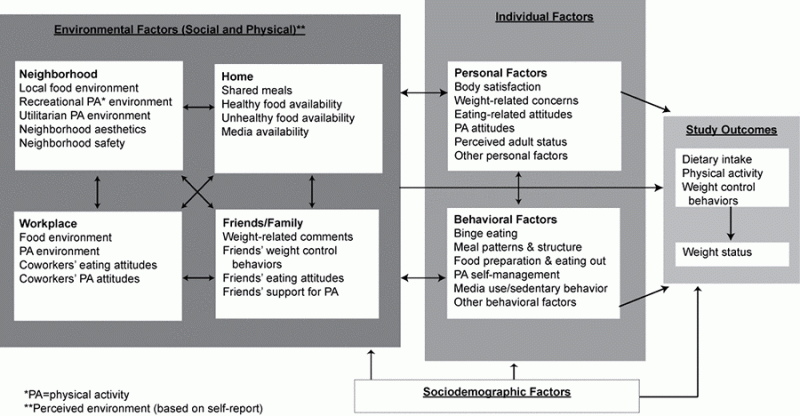
Survey invitation letters providing the web address and a unique password for completing the online version of the Project EAT-III survey and a food frequency questionnaire were mailed to all original Project EAT-I participants for whom contact information was available.
Data collection ran from November 2008 to October 2009 and was conducted by the Health Survey Research Center in the School of Public Health at the University of Minnesota, Minneapolis.
Participants in Project EAT-III
Of approximately 3,442 EAT-I participants contacted by mail, a diverse group of 1,030 men and 1,257 women responded to the EAT-III follow-up survey (66.4% response rate).
Gender:
- 57% females
- 43% males
Mean Age:
- 25.3 year old
Ethnicity:
- 64% Caucasian
- 9% African American
- 17% Asian American
- 4% Hispanic
- 3% Native American
- 3% Other
Funding Source
Grant R01HL084064, National Heart, Lung, and Blood Institute, National Institutes of Health (PI: Dianne Neumark-Sztainer)
Project EAT-IV was designed to extend the follow-up of young people who were surveyed at Project EAT-I to a 15-year period, from adolescence (ages 12-18) to young adulthood (ages 27-33). In addition, surveys were collected from participants’ significant others when applicable and pre-adolescent (ages 9-11) and adolescent (ages 12-18) children of participants.
As a pilot study, up to one pre-adolescent or adolescent child per participant was asked to participate in height and weight measurements and respond to survey questions about their own eating behaviors, physical activity, and weight-related problems. Collecting intergenerational data in future study waves, when a larger proportion of participants are expected to have children ages 9-18 years, will allow for investigation of how weight-related behaviors are passed on from one generation to the next and what factors influence the transmission of these behaviors.
Study Aims
The overall aim of Project EAT-IV was to build a greater understanding of how eating, activity, and weight-related problems, along with the various factors that influence these outcomes, track from adolescence to young adulthood. The research questions addressed by Project EAT-IV were:
- How do eating behaviors, physical activity patterns, and weight-related problems track over the life course from adolescence to young adulthood?
- How do eating behaviors, physical activity patterns, and weight-related problems during adolescence, and relevant individual-level and socio-environmental factors in adolescence, predict young adults own parenting practices regarding eating, activity, and weight? What are the implications for their children?
Research Design
The theoretical model that guided the design of Project EAT-IV was informed by Social Cognitive Theory and an ecological perspective. Additionally, Project EAT-IV was guided by a life course approach to enhance our understanding of trajectories of eating behaviors, physical activity, and weight-related problems, and influences on these outcomes, throughout the lifespan and across generations.
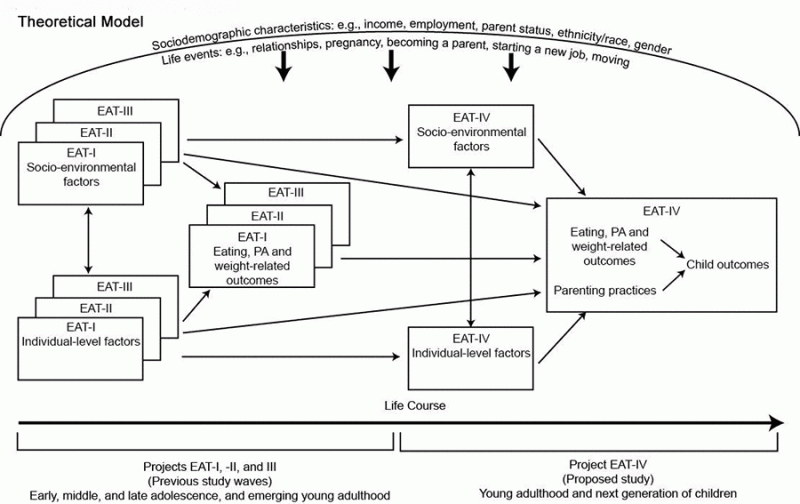
Survey invitation letters, providing the web address and a unique password for completing the online version of the Project EAT-IV survey and a food frequency questionnaire, were mailed to all original Project EAT-I participants who had responded to at least one previous follow-up survey and for whom contact information was available in January 2015. To enhance participant response, a combination of U.S. mail, email, and text message reminders were sent to nonresponders.
Data collection ran from January 2015 to May 2016 and was conducted by Wilder Research, the research arm of the Amherst H. Wilder Foundation, in St. Paul, Minnesota.
Who participated in Project EAT-IV?
Of the 2,770 original participants who could be contacted, a total of 1,830 young adults completed the Project EAT-IV follow-up survey (66.1% response rate).
Gender:
- 59% females
- 41% males
Mean Age:
- 31.0 years old
Ethnicity:
- 68% Caucasian
- 8% African American
- 15% Asian American
- 4% Hispanic
- 5% Other
Funding Source
Grant R01HL116892, National Heart, Lung, and Blood Institute, National Institutes of Health (PI: Dianne Neumark-Sztainer)
EAT 2010-2018 Cohort
The EAT 2010 (Eating and Activity in Teens) study was designed to examine dietary intake, physical activity, weight control behaviors, weight status, and factors associated with these outcomes in a new cohort of adolescents from diverse ethnic/racial and socioeconomic backgrounds in the year 2010. Approximately 2,800 adolescents from 20 middle and high schools in Minneapolis and Saint Paul, Minnesota completed surveys about their weight-related health during the 2009-2010 school year. In addition, measurements of peer, school, and neighborhood environments were completed by peers themselves, school personnel, and research staff. Parents of the adolescent participants were invited to complete surveys as part of the complementary Project F-EAT (Families and Eating and Activity in Teens) study. Of note, this cohort is distinct from the Projects EAT I-IV cohort and was recruited in order to allow for an examination of secular trends in weight-related outcomes among adolescents over the 10-year period from 1999 (Project EAT-I) to 2010 (EAT 2010).
Study Aims
EAT 2010 addressed five major research questions:
- How do weight status and related behaviors among adolescents compare with the Healthy People Objectives?
- How do different factors, including characteristics of environments (i.e., home/family, peer, school, and neighborhood environments), personal factors, and behavioral factors, work together to influence weight status and related behaviors?
- What are the most important environmental, personal, and behavioral influences on weight status and related behaviors for adolescents?
- How do weight status, weight-related behaviors, and influencing factors differ across sex, ethnicity/race, and socioeconomic status?
- What secular changes in weight status and related behaviors have occurred over the past 10 years among middle school and high school students?
Research Design
The EAT 2010 study used an ecological framework to guide the collection of data at the individual, family, friend, school, and neighborhood levels on factors of potential relevance to weight status and weight-related behaviors among adolescents.
Theoretical Model Guiding EAT 2010
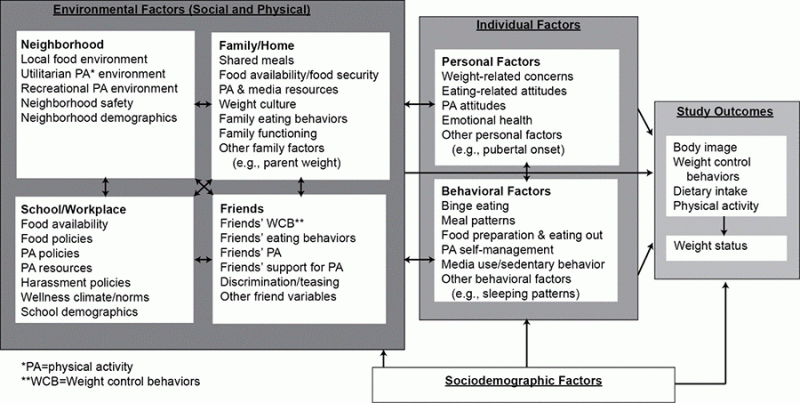
Surveys were administered by trained research staff to middle and high school students in the Minneapolis and St. Paul school districts in Minnesota. Students completed the EAT 2010 Student Survey, a food frequency questionnaire, a physical activity questionnaire, and a friendship nomination form. The friendship nomination form asked participants to identify their three closest female and male friends by selecting their study assigned number from a school list; allowing for an open network, students were permitted to nominate fewer than six friends as well as to indicate whether they had close friends who did not attend their school. Trained research staff also collected student height and weight measurements using a standardized protocol.
Surveys regarding the school environment were completed by personnel at each participating school, including an administrator, food service manager, and physical activity teacher. The surveys were designed to assess school resources, policies, and practices of relevance to eating, physical activity, and weight-related harassment.
Measurements relating to local food environments, utilitarian physical activity environments, recreational physical activity environments, and neighborhood safety were assessed using Geographic Information Systems.
Participants in EAT 2010
2,793 adolescents participated in EAT 2010.
Gender:
- 53% females
- 47% males
Mean Age:
- 14.4 years
Grade Level:
- 46% middle school students
- 54% high school students
Ethnicity:
- 19% Caucasian
- 29% African American
- 20% Asian American
- 17% Hispanic
- 4% Native American
- 11% Other
Funding Source
Grant R01HL084064, National Heart, Lung, and Blood Institute, National Institutes of Health (PI: Dianne Neumark-Sztainer)
Project F-EAT (Families and Eating and Activity in Teens) was an ancillary study to EAT 2010 (Eating and Activity in Teens) designed to examine influences within the family and home environment on the weight-related health of adolescents. Project F-EAT surveys were completed by a sample of approximately 3,700 parents and other guardians of the adolescents enrolled in EAT 2010.
Study Aims
The overall aim of Project F-EAT was to improve our understanding of how the family and home environment influence and the weight-related health of young people. The research questions addressed by Project F-EAT were:
- How do parents of adolescents describe their family and home with regard to weight culture (e.g., parental weight control, parental body image, weight teasing) and the food and physical activity environments; and what are the associations with adolescents’ weight status, body image, weight control practices, dietary intake, and physical activity?
- How do parental reports of the familial and home environment and associations with adolescent eating, physical activity, and weight-related outcomes, differ across ethnicity/race, socioeconomic status, age of adolescent, gender of adolescent and parent, and weight status of adolescent and parent?
- How does the familial and home environment interact with adolescents’ individual characteristics (e.g., body image, weight control behaviors) and peer, school, and neighborhood environments to predict adolescent eating, physical activity, and weight-related outcomes?
- What secular changes have occurred over the past 10 years (1999-2009) in parental reports of weight culture and food and physical activity environments within adolescents’ homes?
Research Design
An ecological framework developed by the research team was used to guide survey development of the Project F-EAT survey. Each section of the survey was reviewed by an expert panel member. Finally, the survey was pilot tested with focus groups with parents of adolescents.
Theoretical Model Guiding Project F-EAT
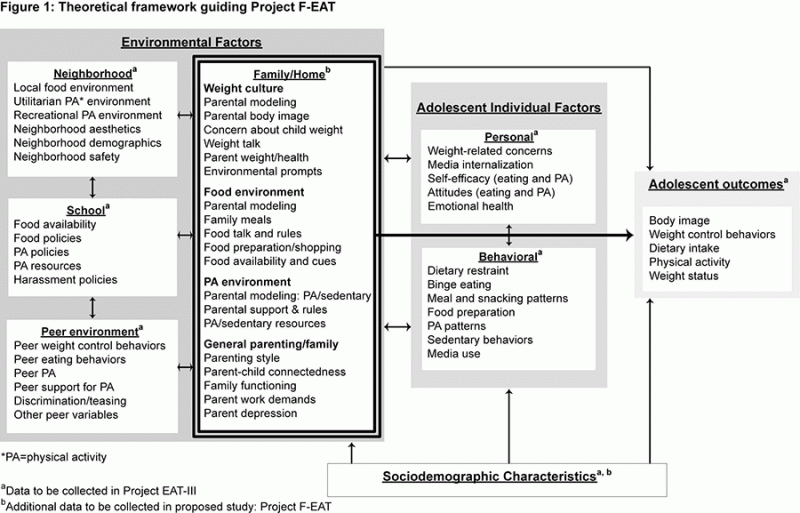
As part of the EAT 2010 study, adolescents participants were asked to identify up to two parents or guardians. Parents were invited to complete the Project F-EAT survey via mail or over the telephone. To meet the needs of this culturally diverse group of parents, both the mailed and telephone survey were available in English, Spanish, Hmong, and Somali and the telephone survey was additionally offered in Oromo, Amharic, and Karen.
Data collection ran from October 2009 to October 2010 and was conducted by Wilder Research in St. Paul, Minnesota.
Participants in Project F-EAT
In total, 3,709 parents/guardians responded to the Project F-EAT survey.
Gender:
- 62% females
- 38% males
Mean Age:
- 42.3 years
Ethnicity:
- 30% Caucasian
- 26% African American
- 21% Asian American
- 17% Hispanic
- 6% Other
Funding Source
Grant R01HL093247, National Heart, Lung, and Blood Institute, National Institutes of Health (PI: Dianne Neumark-Sztainer)
EAT 2010-2018 was designed to examine changes in eating patterns, weight control behaviors, and weight status as the EAT 2010 participants progressed through adolescence and into young adulthood. Approximately 1,600 young people completed the EAT 2018 survey. Data were also collected from participants’ parents/caregivers, friends, and significant others, when applicable.
Specific Aims
The primary aim of EAT 2010-2018 is to identify longitudinal, multi-contextual predictors of a broad array of weight-related problems in a diverse, population-based sample of young people as they progressed from adolescence to young adulthood in order to inform more effective interventions for adolescents and young adults. The research questions to be addressed by EAT 2010-2018 include:
- What individual, family, friend, school, and neighborhood factors predict change in weight-related outcomes from adolescence to young adulthood?
- Do predictors of changes in weight-related outcomes vary among young adults who are from different ethnic/racial and socioeconomic backgrounds and are at different stages in their lives?
- How do individual-, family-, friend-, school-, and neighborhood-level factors interact to predict changes in weight-related outcomes?
Research Design
The research team used an ecological framework to guide the development of the EAT 2010-2018 survey to assess eating, activity, and weight-related behaviors of the young adult cohort, parents/caregivers, and friends/significant others. The survey development process involved pre-testing of draft surveys in focus groups; bicultural review and translation of the parent survey measures into the Spanish, Hmong, and Somali languages; and extensive usability testing of the online forms of the young adult and friend/significant other surveys.
Theoretical Framework Guiding EAT 2010-2018
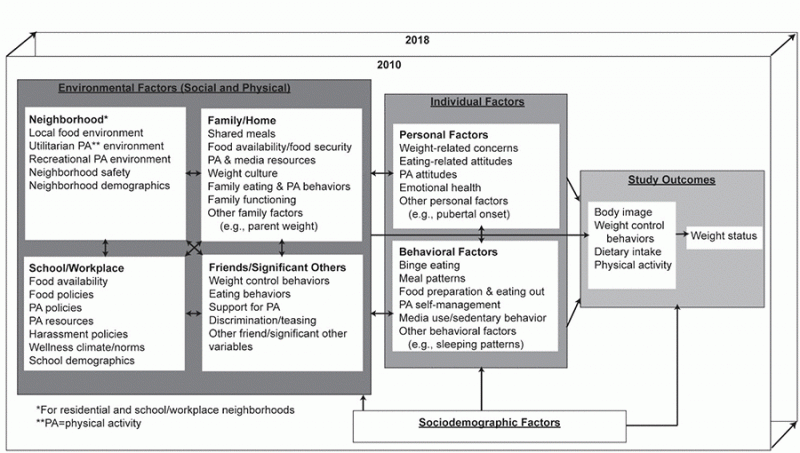
Survey invitation letters, providing the web address and a unique password for completing the online version of the EAT 2018 survey and a food frequency questionnaire, were mailed to all original EAT 2010 participants for whom contact information was available. Additional attempts to contact young people who had not yet completed a survey were made using email, phone calls, text messages, messaging through social media, and home visits.
Data collection ran from June 2017 to November 2018 and was conducted by the Office of Measurement Services at the University of Minnesota, Minneapolis. Data analysis is ongoing, and published manuscripts will be posted on the Publications page as the survey data are analyzed.
Participants in EAT 2010-2018
Of the 2,383 original participants who could be contacted, a total of 1,568 young adults completed the EAT 2010-2018 follow-up survey (65.8% response rate).
Gender:
- 58% females
- 41% males
- 1% Different gender identity (e.g., transgender, non-binary)
Mean Age:
- 22.0 years
Ethnicity:
- 19% White
- 29% African American or Black
- 20% Asian American
- 17% Hispanic
- 4% Native American
- 11% Other
Funding Source*
Grant R01HL127077, Grant R35HL139853, National Heart, Lung, and Blood Institute, National Institutes of Health (PI: Dianne Neumark-Sztainer)
*The EAT 2010-2018 study (R01HL127077) was relinquished at the end of the second study year, given that the Principal Investigator (Dr. Dianne Neumark-Sztainer) was awarded an NIH Outstanding Investigator Award (R35) that will continue and expand upon the originally proposed research through the year 2024. Data collection and analyses were continued as part of the study “Eating, Activity, and Weight-Related Problems Across the Life Course in Diverse Populations” (R35HL139853).
Eating, Activity, and Weight-Related Problems Across the Life Course in Diverse Populations
This Outstanding Investigator Award (R35-OIA) was awarded to Dr. Dianne Neumark-Sztainer to study eating and weight-related problems in adolescents and young adults from low-income and ethnic/racial minority groups in the United States. This program of research is aimed at achieving Dr. Neumark-Sztainer’s vision whereby young people from all backgrounds will have positive weight-related health, with support from their family, friends, schools, worksites, and neighborhoods.
Specific Aims
The research program builds and expands upon the prior Project EAT studies, and aims to identify multi-level factors influencing a broad range of weight-related problems throughout key stages of the life course to guide the development of highly innovative, culturally acceptable, and effective interventions for populations in greatest need. The focus of the research program is on the transition from adolescence to adulthood. Some new research questions include:
- How are different eating and weight-related problems intertwined and how can we work toward the prevention of a spectrum of concerns (e.g., obesity, eating disorders, poor diets, and low physical activity)?
- How can we best address eating and weight-related concerns in populations living in stressful situations, such as poverty, racism, discrimination, and adversity?
- When is less, more when it comes to prevention? For example, can mind/body interventions, such as yoga, help in relieving stress and its outcomes? Are there easy-to-implement strategies that increase the likelihood of families making healthier food choices?
Research Design
The research program includes the following components:
- Longitudinal, multi-level follow-up data collection on weight-related problems from the EAT 2010 cohort (N=2,793);
- Intermediate and rapid response survey mechanisms to capture short-term changes and assess the impact of societal changes and emerging policies of potential relevance to weight-related outcomes;
- Innovative substudies using multiple methods for in-depth explorations of multi-level etiological processes to guide intervention development; and
- A mentored training program for new investigators who will shape the future of the field of young adult weight-related health.
Conceptual framework guiding program of research: multilevel influences across the life course
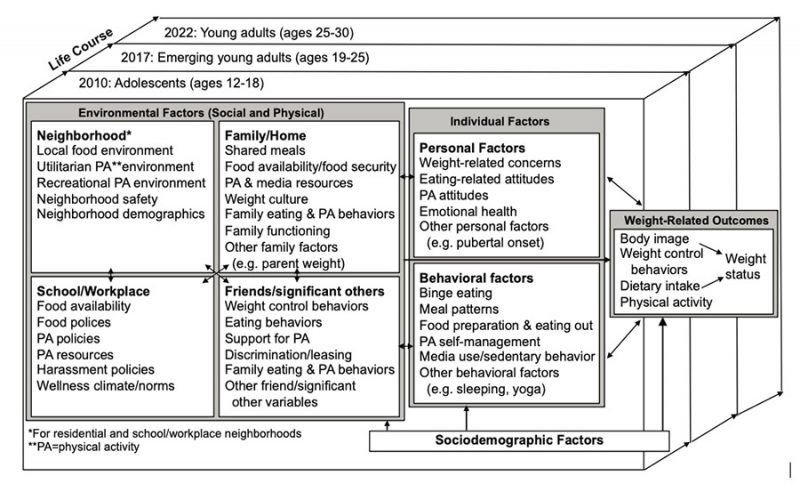
Funding Source
Grant R35HL139853, National Heart, Lung, and Blood Institute, National Institutes of Health (PI: Dianne Neumark-Sztainer)
Project EAT Timeline
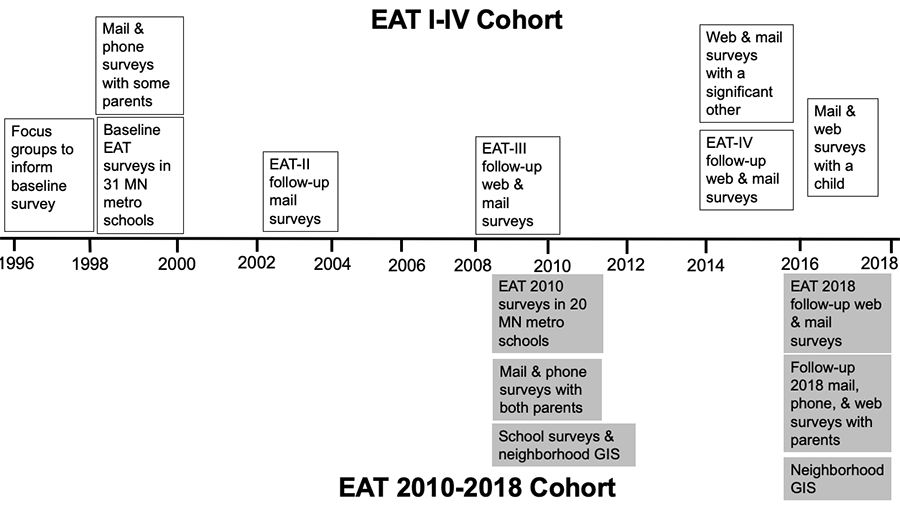
Impact
The Project EAT studies have played an instrumental role in the fields of eating disorders and obesity. To date, Project EAT researchers have produced more than 300 scientific publications, which have been cited over 35,000 times according to Google Scholar.
A review of the scientific literature suggests that findings from Project EAT have also informed over 250 interventions, aimed at improving eating and physical activity patterns, preventing obesity, and reducing disordered eating, weight bias, and body dissatisfaction. For example, Project EAT findings informed:
- A primary care clinic-based program for higher weight adolescent girls that significantly reduced BMI;
- New Moves: A high school physical education program that improved adolescent girls’ sedentary behaviors, unhealthy weight control behaviors, portion control, and body image;
- V.I.K. (Very Important Kids): An elementary school program focused on weight-related teasing that reduced bullying in children; and
- HOME Plus: A community-based intervention focused on helping families have more healthy foods in their homes and eat more healthful family meals together.
Research Team
Current Investigators
- Dianne Neumark-Sztainer (Principal Investigator: EAT-I, EAT-II, EAT-III, EAT-IV, EAT 2010, F-EAT, EAT 2010-2018, R35)
- Daheia Barr-Anderson (Co-Investigator: EAT 2010-2018, R35)
- Jerica Berge (Co-Investigator: EAT-IV, F-EAT, EAT 2010-2018, R35)
- Marla Eisenberg (Co-Investigator: EAT-II, EAT-III, EAT-IV, EAT 2010, F-EAT, EAT 2010-2018, R35)
- Susan Mason (Co-Investigator: EAT-IV, R35)
- Melanie Wall (Statistician and Co-Investigator: EAT-I, EAT-II, EAT-III, EAT-IV, EAT 2010, EAT 2010-2018, R35)
- Katie Loth (Project Director: F-EAT and Co-Investigator: EAT-III, EAT-IV, EAT 2010-2018, R35)
Selected Colleagues and Contributors
- Peter Hannan (Statistician: EAT-I, EAT-II, EAT-III, EAT-IV, EAT 2010, F-EAT)
- Melissa Laska (Co-Investigator: EAT-III, EAT-IV, EAT 2010-2018)
- Richard MacLehose (Statistician and Co-Investigator: EAT-III, EAT-IV, EAT 2010, F-EAT, EAT 2010-2018)
- Ann Forsyth (Consultant and Co-Investigator: EAT 2010, EAT 2010-2018)
- Jayne Fulkerson (Co-Investigator: F-EAT)
- Cheryl Perry (Co-Investigator: EAT-I, EAT-II)
- John Sirard (Co-Investigator: EAT-III, EAT 2010)
- Mary Story (Co-Investigator: EAT-I, EAT-II, EAT-III, EAT 2010, F-EAT)
- Nicole Larson (Project Director)
Other Contributors
Numerous domestic and international investigators, pre- and post-doctoral trainees, and graduate and undergraduate students have collaborated with the Project EAT Research Team.
Funding Sources
Data collection and analyses for Project EAT (Eating and Activity over Time) are currently funded through Dr. Neumark-Sztainer’s “Eating, Activity, and Weight-Related Problems Across the Life Course in Diverse Populations” National Institutes of Health’s Outstanding Investigator Award (R35HL139853).
Previous Project EAT studies (Eating Among Teens, Eating and Activity in Teens and Young Adults) have been funded by the Maternal and Child Health Bureau, Health Resources and Services Administration (R40 MC 00125, PI: Dianne Neumark-Sztainer; R40 MC 00319, PI: Dianne Neumark-Sztainer); and the National Heart, Lung, and Blood Institute, National Institutes of Health (R01HL084064, PI: Dianne Neumark-Sztainer; R01HL093247, PI: Dianne Neumark-Sztainer; R01HL116892, PI: Dianne Neumark-Sztainer; Grant R01HL127077, PI: Dianne Neumark-Sztainer).
Related Grants
K23 HD090324, Eunice Kennedy Shriver National Institute of Child Health & Human Development (PI: Katie Loth)
An exploration of the momentary mechanisms of controlling food-related parenting practices among mothers and fathers of preschool children
This project is using mixed methods, including qualitative interviews and ecological momentary assessment, to identify potentially salient momentary influences on the use and impact of particular food-related parenting practices among parents of preschool-aged children.
R21-DK091619-02, National Institute of Diabetes and Digestive and Kidney Diseases (PI: Jerica Berge)
Risk and Protective Factors for Childhood Obesity in the Home Food Environment
A mixed-methods study including direct observations via 7-day video-recordings of family meals and the home food environment of families of children ages 6-12 years to identify risk and protective factors for childhood obesity.
R03-HD074677-01A1, Eunice Kennedy Shriver National Institute of Child Health & Human Development (PI: Jerica Berge)
All in the Family: Family Members’ Weight and Weight-related Behaviors and Adolescent Obesity, Weight, and Weight-related Behaviors and Adolescent Obesity
Secondary data analysis study to examine the relationship between multiple family members’ weight and weight-related behaviors and adolescents’ body mass index (BMI), dietary intake, and physical activity.
R01HD090053, National Institute of Child Health and Human Development (PI: Susan Mason)
Maternal Early Adversities and Weight During Childbearing
This project examines the weight-related problems during pregnancy faced by women with early life adversities (abuse, neglect, material hardship). The aim of this study is to examine the ways that early life adversities set women up for pregnancy weight problems, and identify ways to mitigate these risks in public health and clinical interventions.
Grant R03HD079504, National Institute of Child Health and Human Development (PI: Nicole Larson)
Patterns of Adolescent Food Intake: Consequences and Contextual Influences
This study investigated snacking behaviors within the context of overall meal patterns, influences on snack consumption, and associations with dietary intake and weight-related health using EAT 2010 data.
Grant R21HD058707, National Institute of Child Health and Human Development (PI: John Sirard)
Social Networks, the Environment and Physical Activity
Using Project EAT-III data, this study examined the relationships between adolescent physical activity and sedentary behavior by incorporating novel data about the social and physical environments in which adolescents spend their time.
Research on Eating and Activity for Community Health (REACH)
The Research on Eating and Activity for Community Health (REACH): An Applied Epidemiology Training Program to Promote Weight-Related Health in Youth and Families from Diverse Communities provides training for the next generation of researchers dedicated to ensuring positive weight-related health among young people and families from diverse communities. The program addresses a broad spectrum of eating, activity, and weight-related problems, including obesity, poor dietary intake, inadequate physical activity, body dissatisfaction, and disordered eating/eating disorders. Dr. Dianne Neumark-Sztainer is the Program Director of this NIH-funded program, which is supported by a Ruth L. Kirschstein National Research Service Award, Institutional Research Training Grant.
Current Openings: There are currently openings for one post-doctoral fellow to begin on or after January 1, 2024. Review of applications will begin immediately and continue until all of the openings are filled. Visit the REACH website for more information about the fellowship and application process.
